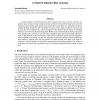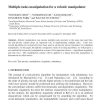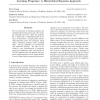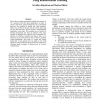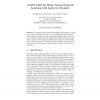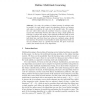ICMLA
2010
14 years 6 months ago
2010
Abstract--Learning multiple related tasks from data simultaneously can improve predictive performance relative to learning these tasks independently. In this paper we propose a nov...
JAIR
2000
14 years 8 months ago
2000
A major problem in machine learning is that of inductive bias: how to choose a learner's hypothesis space so that it is large enough to contain a solution to the problem bein...
AR
2004
14 years 8 months ago
2004
Robotic manipulators can execute multiple tasks precisely at the same time and, thus, the task-priority scheme plays an important role in implementing multiple tasks. Until now, se...
ICML
2010
IEEE
14 years 9 months ago
2010
IEEE
We are interested in learning programs for multiple related tasks given only a few training examples per task. Since the program for a single task is underdetermined by its data, ...
FLAIRS
2004
14 years 9 months ago
2004
Robots that can adapt and perform multiple tasks promise to be a powerful tool with many applications. In order to achieve such robots, control systems have to be constructed that...
FLAIRS
2007
14 years 10 months ago
2007
Context-sensitive Multiple Task Learning, or csMTL, is presented as a method of inductive transfer that uses a single output neural network and additional contextual inputs for le...
FLAIRS
2010
14 years 10 months ago
2010
We present context-sensitive Multiple Task Learning, or csMTL as a method of inductive transfer. It uses additional contextual inputs along with other input features when learning ...
COLT
2006
Springer
15 years 5 days ago
2006
Springer
We study the problem of online learning of multiple tasks in parallel. On each online round, the algorithm receives an instance and makes a prediction for each one of the parallel ...
ICAPR
2005
Springer
15 years 2 months ago
2005
Springer
A non-dominated sorting genetic algorithm is used to evolve models of learning from different theories for multiple tasks. Correlation analysis is performed to identify parameters...
ECRTS
2005
IEEE
15 years 2 months ago
2005
IEEE
Markov-Chain (MC) based constraints have been shown to be an effective QoS measure for a class of real-time systems, particularly those arising from control applications. Scheduli...

